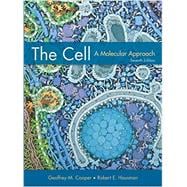Teaching cell biology can be a daunting task because the field is so vast and rapidly moving, characterized by a continual explosion of new information. The challenge is how to teach students the fundamental concepts without becoming bogged down in details. Students need to understand the principles of cell biology and be able to appreciate new advances, rather than just memorizing "the facts" as we see them today. At the same time, the material must be presented in sufficient depth to thoughtfully engage students and provide a sound basis for further studies. The Cell, Seventh Edition, provides a balance of concepts and details that meets the needs of today's students and their teachers. Written by an active scientist and experienced educator, this textbook combines readability and cohesiveness with comprehensive and up-to-date science.
In keeping with prior editions, the new seventh edition:
- Is ideally suited in length and complexity for sophomore- and junior-level courses at the undergraduate level.
- Can be covered in a single semester. Students can master the material in its entirety, rather than sampling a small fraction from a much larger text.
- Is written in an efficient and compact style, covering a broad range of material in a direct and pedagogically approachable manner.
- Focuses on the molecular biology of cells as a unifying theme, with topics such as developmental biology, the nervous system, the immune system, and plant biology being discussed as examples of more general principles.
- Features "Key Experiment" and "Molecular Medicine" boxes that highlight the experimental nature of molecular and cellular biology and convey the excitement and medical relevance of research in this area.
For the Student
Companion Website
The Cell, Seventh Edition, Companion Website provides students with a wide range of study and review materials, rich multimedia resources, and online quizzing. The site is available free of charge (no access code required) and includes the following resources:
* NEW! Videos: A new collection of online videos (referenced throughout the book) helps students visualize complex cellular and molecular structures and processes.
* Online Quizzes: Two sets of online quiz questions are available for each chapter, both of which are assignable by the instructor.
- Multiple-choice quizzes test comprehension of the chapter's key material.
- Free-response questions ask students to apply what they have learned from the chapter.
* Animations: Narrated animations help students better grasp key complex topics and processes.
* Micrographs: Interactive versions of the many micrographs in the book, illustrating cellular structure.
* Flashcards & Key Terms: A great way for students to learn and review the key terminology introduced in each chapter.
* Chapter Summaries
* Web Links
* Complete glossary
For Instructors (available to qualified adopters)
Instructor's Resource Library
The seventh edition Instructor's Resource Library includes a wide range of digital resources to aid instructors in planning the course, presenting lectures, and assessing students. The IRL includes the following resources:
* NEW! Data Analysis Problems: New for the seventh edition, this set of over seventy problems presents students with real-world analysis exercises. Each problem is built around figures and data from specific published papers, and students are challenged to interpret the figures, analyze data, and explain methods and results. Complete answers and explanations are provided. Ideal for use as in-class exercises or as homework assignments.
* Textbook Figures & Tables: All available as both high- and low-resolution JPEGs
* PowerPoint Resources:
- Figures and tables
- Complete lecture presentations
- Supplemental photos
* Animations: The entire collection of animations from the Companion Website, for use in lecture
* Supplemental Photos: Over 100 additional micrographs
* Online Quiz Questions: Multiple-choice and free-response questions from the Companion Website, with answers and feedback
* The complete Test File, in Microsoft Word and Diploma formats (see below for details)
* Chapter Outlines and Key Terms
Test File (available in the Instructor's Resource Library)
Revised and updated for the seventh edition, the Test File includes a collection of over 1,300 multiple-choice, fill-in-the-blank, true/false, and short-answer questions covering the full range of content in every chapter. New for the Seventh Edition, all questions are referenced to Bloom's Taxonomy, making it easier for instructors to select the specific types of questions they want when building an assessment.
Computerized Test Bank (available in the Instructor's Resource Library)
The entire test file plus all of the online quiz questions are provided in Blackboard's Diploma software. Diploma makes it easy to assemble quizzes and exams from any combination of publisher-provided questions and instructor-created questions. In addition, quizzes and exams can be exported to many different course management systems, such as Blackboard and Moodle.
Online Quizzes
The Cell's Companion Website features pre-built chapter quizzes (see above) that report into an online gradebook. Adopting instructors have access to these quizzes and can choose to either assign them or let students use them for review. (Instructors must register in order for their students to be able to take the quizzes.) Instructors also have the ability to add their own questions and create their own quizzes.








